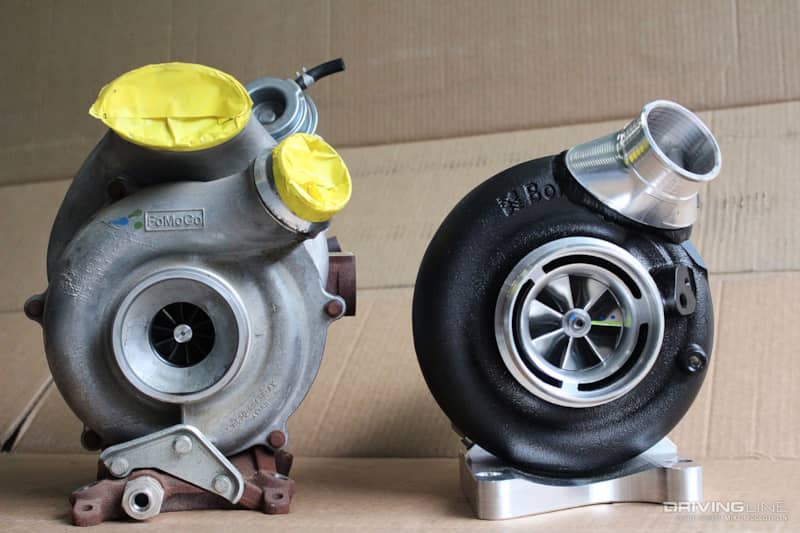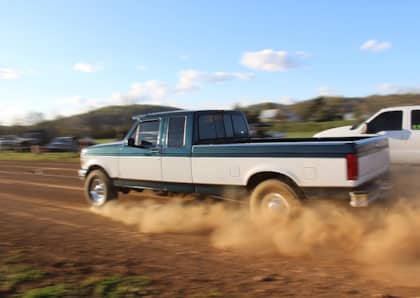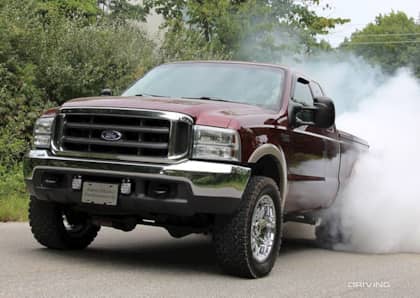2011-2014 Post-Warranty Power Stroke Fix Part 1: Ditching the VGT
Compared with the Navistar-built 6.4L and 6.0L Power Stroke engines that preceded it, Ford’s 6.7L Power Stroke is a beast. Not only has it earned a reputation for high-mile durability, but it’s also the most powerful, cleanest-burning V8 diesel to ever grace the Super Duty truck line. But despite all of its accolades, early engines had their drawbacks, the biggest of which being the turbocharger used on ’11-’14 F-250, F-350 and F-450 pickups (cab & chassis models excluded). While ultra responsive, the dual compressor wheeled, variable geometry turbo proved overly restrictive, producing excessive drive pressure and often falling victim to overspeed failure.
In 2015, Ford switched to a traditional, single compressor variable geometry turbo, and retrofit kits for ’11-’14 trucks soon followed. But while ’15-newer turbos have proven much more reliable, for utmost reliability and airflow there is simply no replacement for a fixed geometry turbocharger. What you lose in spool up, you always gain back in mid-range and top-end power. Luckily, company’s like Maryland Performance Diesel have developed a way to mount a fixed geometry unit directly in place of the factory VGT without having to scrap the upper and lower intake plenums, the intercooler piping or even the OEM downpipe.
It Just Makes Sense
As the early 6.7L-powered Super Dutys begin to come out of warranty, it doesn’t take much to sell an ’11-’14 Power Stroke owner on a turbo upgrade. Either fork over $2,000 for a drop-in replacement unit that’s guaranteed to meet the same fate or invest in a turbo system that will last the life of the truck. With the OEM turbo on its way out, the owner of the ’13 F-350 in this article was faced with this exact proposition. After opting for Maryland’s Quick Spool budget turbo kit, the Power Stroke-savvy folks at Flynn’s Shop in Alexander, Illinois dug into the 93,000-mile dually.
In Part 1, we’ll discuss the level of involvement in the teardown process on a 6.7L Power Stroke. For Part 2, we’ll cover the installation of the new turbo system, along with a budget-friendly high-pressure fuel pump upgrade.
An Extensive Job

It’s a tall order to install a whole new system on a 6.7L Power Stroke in one day, so if you’re doing this in your driveway make sure your schedule is clear the entire weekend. Also make sure you’re using a topside creeper or your favorite fender blanket during the job. Your mid-section will thank you later on.
5-Gallon Bucket(s)

First things first, pull the grille. With so much money and labor involved in repairing today’s diesel pickups, the last thing you want to do is scratch or dent the face of your Ford. Then move on to draining the coolant, but remember that the 6.7L Power Stroke has two separate cooling systems, and both need to be drained before you get started under the hood (one system is dedicated to the engine while the other serves the water-to-air intercooler, transmission and the EGR system).
Digging In

Once the air intake, turbo boost sensor, upper section of the turbo downpipe and intercooler piping are removed, the composite upper intake plenum can be unbolted and pulled off of the engine. Notice the painter’s tape being employed on the inlet of the lower intake to keep debris from entering it. The same should be done on the inlet and outlet of the intercooler, as well as the intake manifold openings on the valve covers.
Lower Intake Plenum

From there, the cast-aluminum lower intake plenum can be unbolted from the valley, detached from the turbo compressor housing and removed. It’s worth noting that some aftermarket turbocharger kits for the 6.7L Power Stroke scrap the upper and lower plenums, but they’re both retained in Maryland Performance Diesel’s Quick Spool budget turbo system.
It’s What Beds Are For…

With the turbo literally buried at the back of the lifter valley in 6.7L Power Stroke applications, it pays to keep track of everything you pull off of the engine. The techs at Flynn’s (and virtually every other diesel shop we frequent) are able to do just that by placing all removed items in the bed. As you can see, bed space shrinks fast when you’re pulling parts off a 6.7L Ford.
Guaranteed to Fail

This is another shortcoming present in the OEM turbocharger system: the cold-side intercooler pipe (intercooler to engine). Under high boost and after prolonged exposure to excessive heat, this plastic tube is notorious for blowing apart and stranding you. For anyone that tows, failure of this component means your truck is unable to build boost and is essentially rendered unusable until it can be replaced.
The Cold-Side Cure

Because the new, fixed geometry turbo will likely produce higher boost pressure and certainly flow more air volume, now is the time to upgrade away from the failure-prone cold-side intercooler pipe. Once again to the rescue, Maryland offers an intercooler pipe fix, which replaces the plastic factory piece with a stainless steel, mandrel-bent and bead-rolled version (with a new IAT sensor pre-installed to boot), along with a high-flow aluminum throttle body adapter. The adapter is shown being installed on the lower intake plenum in the image above.
Finally, Accessible

Prior to removing the factory turbo, the driver and passenger side up-pipes were unbolted from both the turbo and exhaust manifolds (note: the 6.7L Power Stroke’s reverse-flow cylinder heads mean the exhaust manifolds are located in the lifter valley). To access the nuts on the passenger side exhaust manifold studs, the inner fender well may have to be removed. After that, the wastegate solenoid and external coolant and oil lines should be disconnected from the turbo and all four pedestal bolts broken free.
Goodbye Garrett

Space is definitely limited between the turbo’s wastegate diaphragm and the Super Duty’s cowl, but the factory unit can be pulled without a lot of frustration. The primary obstacle is the fact that the turbo weighs more than 50lbs, so maneuvering it around requires a bit of muscle. Of course, the guys at Flynn’s are well-versed in 6.7L turbo systems (and working with heavy diesel components) and made quick work of removing it.
Modern Marvel Vs. Old-School Simplicity

Here you get a look at the factory VGT’s replacement: an S364.5 SX-E from BorgWarner. By comparison, the two turbos are night-and-day different. The factory Garrett GT32 SST utilizes two 46mm (inducer) compressor wheels and two air inlets, no map width enhancement groove, a variable geometry turbine housing, an internal wastegate and a water-cooled, ball bearing center cartridge. Contradictory to all of that, the S364.5 SX-E sports a single 64.5mm compressor wheel with a conventional air inlet, has a map width enhancement groove, a fixed geometry turbine housing, no wastegate and an oil-cooled, journal bearing center cartridge. As far as turbo technology is concerned, it’s practically AI vs. a dinosaur…and the dinosaur wins.
MPD-Massaged BorgWarner SX-E

While the S364.5 SX-E is an off-the-shelf charger straight from BorgWarner, its original compressor housing outlet is cut off at Maryland Performance Diesel and replaced with its own billet outlet in order to accommodate the 6.7L engine’s factory hot-side intercooler pipe. The folks at MPD also machine their own pedestal in-house and ship the turbo as a complete, bolt-in-ready assembly. On the performance front, the forged milled (FMW) 64.5mm compressor wheel flows more than 80 lbs/minute (1,150+ cfm), which is enough to support 650rwhp.
Tidying Up

Prepping the lifter valley for the new turbo and pedestal should entail a few shots of compressed air in each pedestal bolt hole. This ensures no coolant or other fluids are present when you reinstall the pedestal bolts. In addition, the mating surface of the pedestal gasket on the block should be thoroughly cleaned for an optimum seal with the new gasket in the mix. Removing leftover gasket material can entail a die grinder/Scotch-Brite pad combination, just don’t get too aggressive.
Functional Bling

Because the new turbo has no provision to accommodate the second air inlet on the back side of the lower intake plenum, it gets plugged off with the billet-aluminum plug Maryland supplies with its turbo kit. The oval block-off is held in place using the OEM boot and clamp.
Take My Money!

Keeping with the budget theme of Maryland’s turbo kit, the factory two-piece downpipe is retained thanks to the billet adapter attached to the turbine housing. With the factory downpipe not known as a major restriction in the 500 to 650hp range, this is definitely a cost savings that truck owners welcome.











